The content of the article
Our kitchen does not actually do without garlic: no matter what country of the CIS you take - fragrant vegetables with meat and vegetable dishes, in sauces, pickles and pickles are used in the north and in the south. Garlic stays fresh all year round, retaining its beneficial properties. Therefore, gardeners and gardeners are trying to stock up on a useful vegetable for the future and grow a good harvest on their land.
Experienced gardeners know that garlic is bred in two ways. In the spring they plant bulbs and get small seedlings by autumn. In the fall, the garlic is planted with rooted teeth. From such seedling large fragrant heads of a vegetable turn out. But in order to achieve high-quality harvest, it is necessary to carry out preparatory work and fulfill several important requirements, ranging from choosing a place, preparing the ground and selecting seedlings, and ending with the correct planting of garlic.
How to choose a place for garlic beds
Garlic is a tender and sensitive plant.It prefers a neutral or alkaline loamy soil and is very whimsical to "neighbors". When you plan to plant garlic, plan a place for it in advance. In no case should the cloves be planted after tomatoes, potatoes or legumes. This can lead to the development of fungal diseases on the plant. If there are not so many options, the soil will have to be treated with a disinfector and fertilizers.
It is also undesirable to combine a spicy vegetable with onions or sow a new “layer” of garlic 2 years in a row. Growing garlic in the same place again will happen only after three years, otherwise the harvest will be poor. This is due to what elements the plant stores from the soil and which gives. When the soil is "poorer" after planting. It must be fed with compost, mineral additives, and also treated with antimicrobial solutions, so that new plantings receive enough nutrition and do not hurt. This is the only way to get a high-quality crop that is good for health.
Whenever possible, garlic is planted on the beds left over from berry bushes, lettuce, melons, sweet pepper and other light annuals. Nearby you can arrange beans, tomatoes or cabbage.It is undesirable to arrange a row of garden radish, beets or carrots - this will have a negative effect on the garlic harvest. Although for carrots, garlic will be a good helper: it drives away harmful insects and allows root crops to grow to its fullest might.
Garlic doesn’t like stagnation of water, so it’s not worthwhile to have beds in lowlands with the risk of convergence of melt water or near non-drying rain puddles. However, elevated areas substitute garlic winds and frost. Ideally, a well-lit island with flat terrain is needed.
Interesting fact! Update periodically seedlings necessarily, otherwise the head will be rough and lose the smell. Once every 3-4 years it is necessary to start a new seedling from the spring. The crop in this case is obtained in the second year. Each time to start with the bulb is not necessary.
Plant large cloves for the winter to take off fragrant fruits by summer. You can update the seedlings in parts, adding fresh teeth to mature ones, but it is better to plant them in different rows.
When to plant garlic correctly
Lay the seedlings in the autumn chill a month before the arrival of frost, but after the thaw. In various regions, this is the period from mid-September to the very end of October. Prepare the beds in advance.
If you plant the garlic too early - it will have time to germinate and the seedlings will spoil - the greens should not appear until spring, so as not to fade under a layer of snow. In this case, the teeth should have time to take root, and this means that the temperature of the soil should be about 15 degrees Celsius. At the same time there should be no warm rain, stimulating the growth of greenery. Folk calendar offers for planting garlic in temperate climates mid-October - before the feast of the Intercession.
How to fertilize the land for garlic
Compost and ash are used to prepare the land, and the soil is “deacidified” with lime or dolomite flour. Manure beds for garlic do not need to fertilize, it will lead to destruction of seedlings. It is better to use manure previously, fertilizing the previous plants in the spring and in the summer.
To prepare the land for planting garlic, it is necessary to dig up the soil 2 weeks before placing the seedlings. Depth - in 1 shovel. The loosened earth is poured with fertilizer and allowed to settle.Potassium sulfate (2 spoons / sq. M.) And double superphosphate (1 spoon / sq. M.) Are used; compost is taken in a bucket per meter.
The development parameters of the beds - up to 20 cm in height and 1 m in width.
If the seedlings are immersed immediately in the dug-up soil, the garlic grains will go deep into the soil and will be tamped down, after which it will be difficult for them to germinate, which means that the harvest will be poor and small.
To cultivate the soil after "harmful" predecessors, prepare copper sulfate. For 2 liters of hot water take 1 tbsp. copper sulfate. The solution is poured into 5 liters per 1 sq. M. Fertilized soil is recommended to cover the film.
If you do not want to use chemicals to sterilize the soil, the earth can be cleaned in a natural way. To do this, in the middle of August it is covered with mustard, pea and oats or rye. The distance between the seedlings should be about 30 cm. By the time the garlic is planted, the plants sprout by 20-30 cm. Garlic is laid between them. Greens remain in the soil as an organic fertilizer that will rot over the winter and will come in handy in the spring when garlic starts breaking through the first greens early.
How to choose garlic for seedlings
For the seedlings to start and produce a high-quality crop, you need to choose large teeth. From fine planting material grow weak heads of garlic. So every year it can become smaller and eventually degenerates.
They select dry large heads with solid dense teeth and separate them from each other, putting them in the husks. It is necessary to reject soft, refracted, fused or undeveloped grains, and sterilize the remaining material from pests with manganese, vitriol, or calcined in the oven.
Already in March, garlic will show sprouts up to 20 cm and a long growing season will pass. Garlic does not like heat, and actively grows in the spring, picking up juices in greens. When the heat begins, its heads ripen, and the greens fade. In the heat, the garlic nods hidden in the ground imbue with fragrant spicy aroma and store healing components. That is why the green garlic is cut off early in warm weather, and the bulbs are not dug up until the heat subsides. Ripe saturated slices become fertile seedlings for a good harvest.
Choose varieties with large teeth. In such varieties, even small heads have good spreading material, just 3-4 cloves are formed on one rod, unlike the standard variants of 6-8 cloves.Even if you can not use such material for seedlings, it is very useful to you for blanks. It is much more convenient to peel large cloves of garlic: it is faster and easier to do manually, and the large format of the vegetable is more suitable for pickles and marinades. Such garlic is often used as a whole, for example, by digging into pilaf or stuffing a bird, while small garlic — not so nobly spicy, but more spicy — has to be crushed or shred for dishes. Such immature teeth are not suitable for seedlings at all.
How to plant garlic on rooting
Garlic is planted 15 days after digging, when the earth breathes and is saturated with fertilizer. Make small grooves with intervals of 15 cm. It is recommended to lay a plate in the passage when disembarking:
- This will help not to trample just set teeth.
- It will compact the soil to protect the garlic from premature germination or freezing.
- Allows you to conveniently measure the distance between the rows.
Some sources propose to deepen cloves by 30 cm. However, this is a controversial issue. With such a depth of planting greens it will be difficult to break through.In a snowy winter, the precipitation layer “wraps” the soil - and the seedlings will not freeze.
In each groove loosening pits of 5 cm and lay large cloves of garlic one by one with a distance of 15 cm. After that, it is sprinkled with earth, which may contain elements of mulch, and leave for the winter.
Winter garlic usually endures cold, dissolves early and produces fragrant, large and juicy fruits. You can start digging them in the summer - the young teeth will be sharper. Late garlic usually has a mild spicy taste and is stored in dried form in stocks for the whole winter.
Video: the correct planting of garlic in the fall

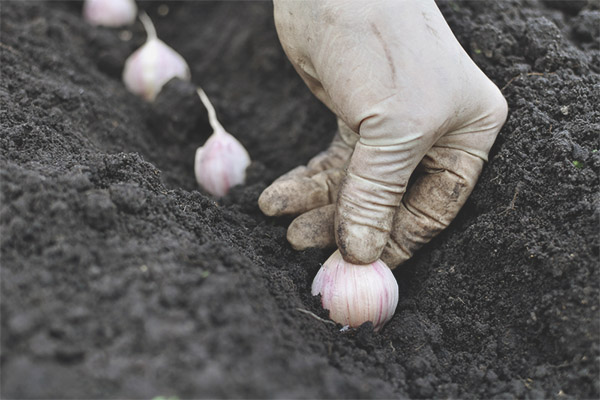
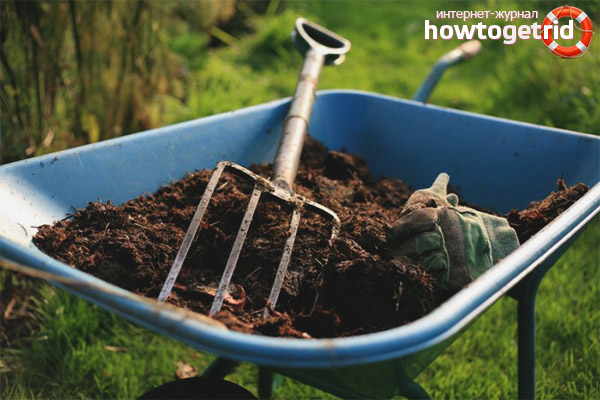
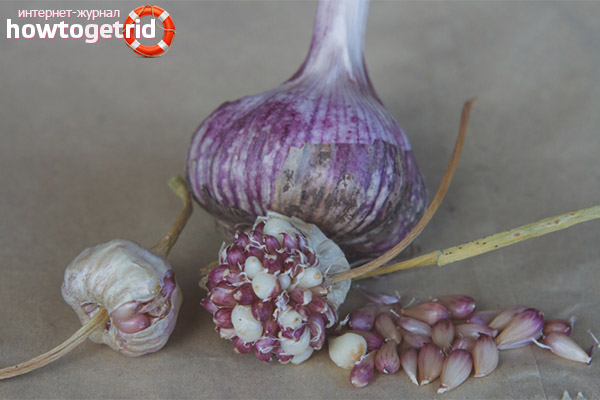

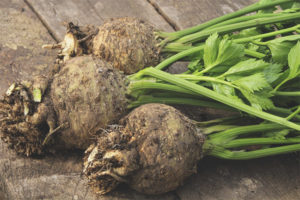
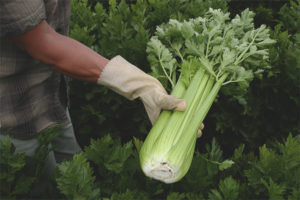

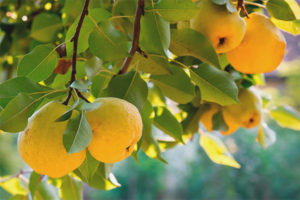
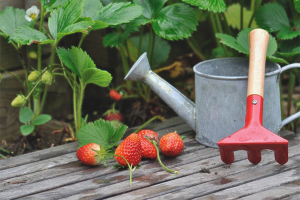

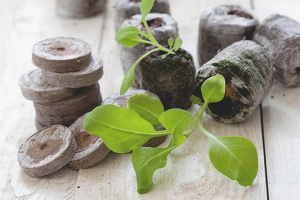
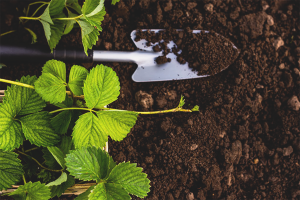
To send